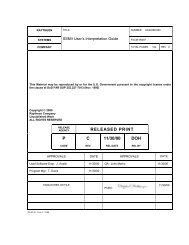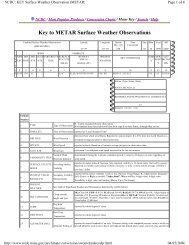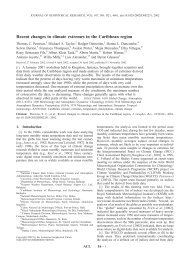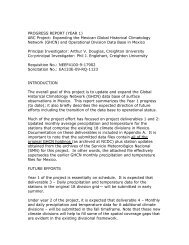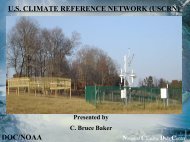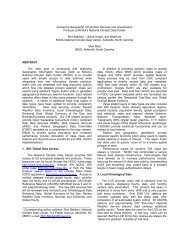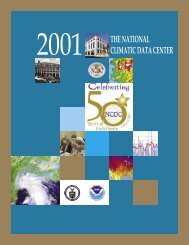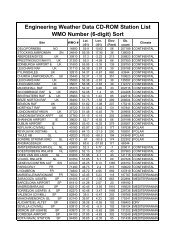CONSTRUCTION - National Climatic Data Center - NOAA
CONSTRUCTION - National Climatic Data Center - NOAA
CONSTRUCTION - National Climatic Data Center - NOAA
Create successful ePaper yourself
Turn your PDF publications into a flip-book with our unique Google optimized e-Paper software.
<strong>NOAA</strong>’s <strong>National</strong> <strong>Climatic</strong> <strong>Data</strong> <strong>Center</strong>Sectoral Engagement Fact Sheet<strong>CONSTRUCTION</strong>OVERVIEWThe construction industry is comprised of a wide range of businesses involved inengineering standards, building design, and the construction of various types of materials andstructures. This sector is affected in many ways by climate change and variability as well asextreme weather events. Long-term climate impacts, such as sea-level rise, coastal erosion,and drought; and short-term weather-related impacts, such as high winds and flooding,influence the choice of site construction, building techniques, and materials. The potentialrisk of inclement weather and climate conditions can influence planning project completiontimelines. A changing climate can lead contractors to build smarter structures that are moreenergy efficient and cost-effective. Facilities can be designed, built, operated, and regulated towithstand, manage, or harness the impacts of weather and climate. Having access to relevantand easily understandable weather and climate data is essential for strategic planning purposes,risk management, and assessing environmental footprints.KEY STAKEHOLDERS<strong>NOAA</strong>’s <strong>National</strong> <strong>Climatic</strong> <strong>Data</strong> <strong>Center</strong> (NCDC) works with various groups, both as aninformation provider and as an applied research partner, to examine the effects of weather andclimate on construction. This type of information can help engineers, builders, and decisionmakers within the construction sector make practical decisions in order to adapt to climatechanges and variations and to mitigate possible effects. There are many different governmentand non-governmental organizations, and public and private groups and businesses that canbenefit from using relevant climate and weather-related information. Some major groupsinclude:• Corporations that contribute in various ways to construction• Professional societies and trade groups• State natural resource and transportation departments• City and county governments• State environmental agencies• Academia and other researchersSECTOR NEEDSClimate information is often available only as raw observations or in the form of tables,graphs, or written summaries, which may be difficult for users who are not well-versed inclimate science to fully interpret. To bridge this gap, NCDC is partnering with groups within theindustry to translate climate data into accessible, useful, and accurate products; and to leverageNCDC’s climate expertise to better understand what the information means and how it can beused most effectively.Climate information can be used in a variety of ways. Some examples include:• Using precipitation data to design and build natural gas pipeline trenches that will withstandsaturated ground conditions.• Using temperature data to determine the optimal thermal characteristics of buildings forinsulation purposes, and to determine heating, cooling, and ventilation requirements.• Using precipitation data to develop erosion control procedures for construction projects.• Using rainfall data to help determine optimal locations for building new outdoor sportsarenas.• Using past hurricane information and related meteorological data to help in the constructionof residential and commercial buildings, including floating docks in coastal regions.
• Using historical rainfall data to plan ahead for “rain days”—days in which nooutdoor work can be conducted due to precipitation events—during constructionprojects.• Using ice thickness and freezing rain data for engineering design consideration inthe construction of certain structures that are subject to outdoor weather.NCDC DATA AND PRODUCTSThere are many different types of useful climate information available.Examples include:• Surface observations made at thousands of locations across the globe for hourly,daily, and monthly averages.• Summaries produced from data, such as temperature frequency distributions.• Climate Normals, which are the average values of meteorological elements, suchas temperature, precipitation, frost/freeze data, and snowfall data, over 30 years.The normal climate helps describe the climate and is used as a base to whichcurrent conditions can be compared.• The Air Freeze Index, which is a measure of how much and how often air temperaturesare above and below freezing during the winter, useful for determining if Frost-ProtectedShallow Foundations (FPSF) should be utilized.• Global tropical cyclone positions and intensities in the International Best Track Archivefor Climate Stewardship (IBTrACS) tropical cyclone database.• CD-ROM/DVDs, such as the International Station Meteorological Climate Summary,which contains climatic data summaries from thousands of weather stations around theworld, and Integrated Surface <strong>Data</strong>, which contains climate information dating as far backas 1901 for about 10,000 weather stations.• Publications, including Local Climatological <strong>Data</strong> (provides monthly average values),Climatological <strong>Data</strong> (provides monthly and annual average values), Comparative <strong>Climatic</strong><strong>Data</strong> (provides average and extreme values), and Storm <strong>Data</strong> (provides monthly reportsof damaging weather).Collaboration between climate scientists and the construction community is essential in helping to build thenecessary bridges that will transform climate science into information that is relevant and credible. Having<strong>NOAA</strong> membership on selected committees has proven to be an excellent way to improve communication andinformation use. Ongoing communication is important to ensure that the information that NCDC provides isappropriate and applicable to construction sector needs. As climate changes in the years ahead and the effectsbecome more noticeable, new information needs will emerge. NCDC will work closely with this sector, attendingtrade meetings and sponsoring future workshops and conferences, in order to better understand, address, andanticipate these needs.Additional details about available <strong>NOAA</strong> products and the economic benefits of these products are provided at:http://www.economics.noaa.govFor further information on obtaining NCDC climate services and products related to construction please contact:Customer Services Branch<strong>NOAA</strong>’s <strong>National</strong> <strong>Climatic</strong> <strong>Data</strong> <strong>Center</strong>151 Patton AvenueAsheville, NC 28801-5001 U.S.A.828-271-4800 • TDD 828-271-4010Fax 828-271-4876E-mail: ncdc.info@noaa.govhttp://www.ncdc.noaa.govAgriculture ▪ CIVIL INFRASTRUCTURE ▪ Coastal Hazards ▪ Energy ▪ Health ▪ InsuranceLitigation ▪ Marine and Coastal Ecosystems ▪ <strong>National</strong> Security ▪ Tourism ▪ Transportation ▪ Water Resources<strong>NOAA</strong> Satellite and Information Service<strong>National</strong> Environmental Satellite, <strong>Data</strong>, and Information Service (NESDIS)<strong>National</strong> <strong>Climatic</strong> <strong>Data</strong> <strong>Center</strong> (NCDC)U.S. Department of CommerceJune 2010



